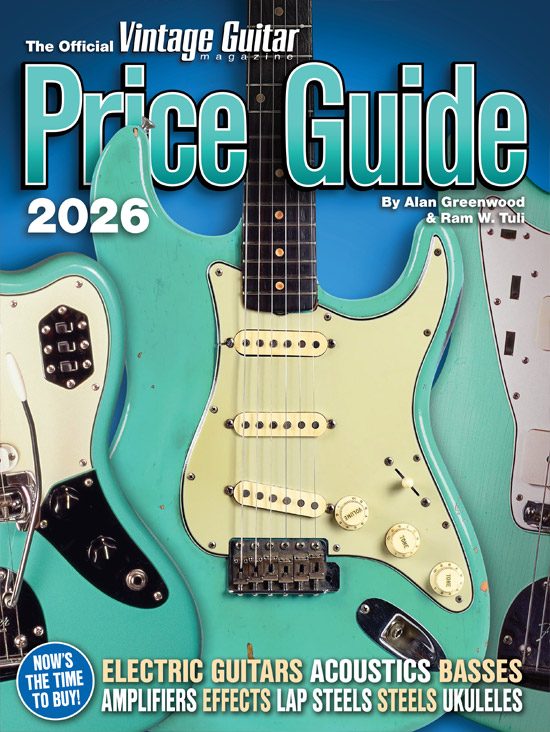
Ladies and gentlemen, Jared James Nichols is bringing savagery back to rock and roll. His weapon of choice – vintage Les Pauls. His latest self-titled album bristles with ferocity where bluesy grunge meets trippy psychedelia. His playing is intense, yet virtuosic, and Nichols has a secret weapon that manifests his pentatonic fury. Here, he tells all.
You manhandle the bejesus out of your guitars.
That’s my mission: How do I get that live sound and energy? Half of that is the battle within myself. I said, “You know what? I’m going to play the guitar like I mean it! I’m just going to f***ing lay into it!” I co-produced this record with a friend, Eddie Spear. He’s a young guy from England. He said, “I don’t want to make a safe record. I want to make a record where, when you turn it on, it feels like the speakers are ready to explode.” I would push it, then he would push it, and then I would try and push it further. We were trying to one-up each other the whole time. I think it made a more-energetic record.
It’s raw-sounding, as well.
When I play shows, people come up to me and say, “Jared, you sound awesome on your records, but your live shows are where it’s at!” We didn’t use a computer. We went straight to tape. The whole record was tracked live in the same room, minus the vocal, straight-to-tape. My vocals and four shimmery guitar overdubs are the only ones on the record. We didn’t double-track anything; we had one microphone on the guitar, four mics on the drums, and one on the bass – and we were tracking loud. My ears were ringing for a week from standing in front of a 1968 100-watt Marshall Super Lead for two days (laughs).
When I think of guitar-focused records, I think of a lot of production – very slick playing, where everything is perfect. I’m not a perfect person in that regard. I make mistakes, I play hard, and I mess s**t up. At the end of the day, it’s more about the humanity behind it. We went for that with this record, and I think we got it.
How did you track “Down The Drain?”
We finished the record, and I had that song sitting on the back burner. I played the demo for a few people, and they were like, “Yeah, that needs to go on the f***ing record!” I ended up tracking that through a Leslie speaker – not only for my guitar, but I plugged the bass into it. All of that weirdo Soundgarden-esque vibe stuff is going through that Leslie.
One cool part that we ended up doing was after the solo section, where we added this cool drum fill. That was the only editing. We thought of it like a Beatles-meets-Sabbath drum fill.
What other effects did you use?
I ran through three effects pedals – an old Tube Screamer, I borrowed a Klon from Joe Bonamassa, and I had a wah. Eddie was running an Echoplex. As we were tracking my solos, I’d hear the Echoplex going crazy. He was playing off of me. There’s a solo on “Easy Come, Easy Go” where you can hear him revving it up. It’s super-psychedelic. When you’re playing at a certain volume in that style, my mind wants to go heavy and then psychedelic. I feel like the two mesh well. Eddie kept saying, “Let’s bring evil back to rock and roll (laughs)!”
How are you managing your severe addiction to Les Pauls?
Well, I was born in the same town as Les – Waukesha, Wisconsin – and I tried everything and kept coming back. I love P-90 Les Pauls; one of my biggest heroes is Leslie West, from Mountain, and there are only P-90s on this record. I have a ’53 wrap-tail called Old Red that I used for 90 percent of the record, and that thing smokes.
I love the early Les Pauls – I call them “the underdog ’50s” – ’52, ’53. Those were some cool-ass guitars. One of my others is a ’52 goldtop named Dorothy, with the old-school Super 400 tailpiece. That guitar was in a tornado and I had it restored. It’s one of my favorite guitars in the world. It kills. I’ve played a lot of guitars, but that one has the sauce.
What is it about P-90s that keeps you there?
P-90s get all the in-between sounds. They get the syrupy humbucker sparkle, and you can also roll it back. I play with my fingers, and they help get that percussive attack when I’m trying to get more dynamics.
This article originally appeared in VG’s November 2023 issue. All copyrights are by the author and Vintage Guitar magazine. Unauthorized replication or use is strictly prohibited.



